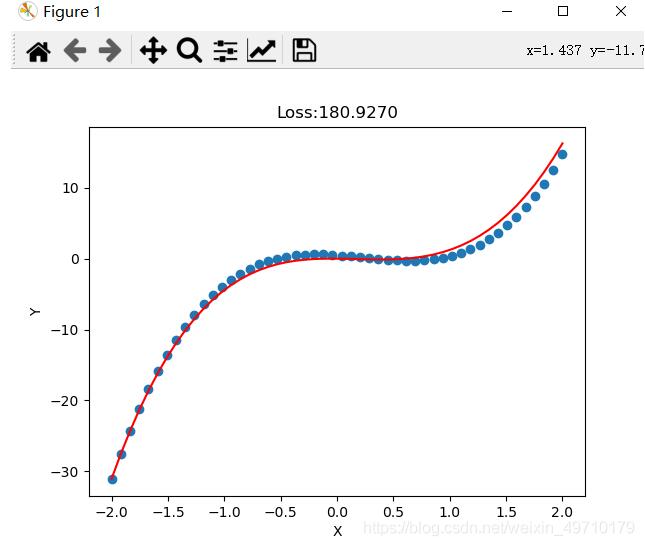pytorch实现多项式回归,供大家参考,具体内容如下
一元线性回归模型虽然能拟合出一条直线,但精度依然欠佳,拟合的直线并不能穿过每个点,对于复杂的拟合任务需要多项式回归拟合,提高精度。多项式回归拟合就是将特征的次数提高,线性回归的次数使一次的,实际我们可以使用二次、三次、四次甚至更高的次数进行拟合。由于模型的复杂度增加会带来过拟合的风险,因此需要采取正则化损失的方式减少过拟合,提高模型泛化能力。希望大家可以自己动手,通过一些小的训练掌握pytorch(案例中有些观察数据格式的代码,大家可以自己注释掉)
|
1
2
3
4
5
6
7
8
9
10
11
12
13
14
15
16
17
18
19
20
21
22
23
24
25
26
27
28
29
30
31
32
33
34
35
36
37
38
39
40
41
42
43
44
45
46
47
48
49
50
51
52
53
54
55
56
57
58
59
60
61
62
63
64
65
66
67
68
69
70
71
72
73
74
75
76
77
78
79
|
# 相较于一元线性回归模型,多项式回归可以很好的提高拟合精度,但要注意过拟合风险# 多项式回归方程 f(x) = -1.13x-2.14x^2+3.12x^3-0.01x^4+0.512import torchimport matplotlib.pyplot as pltimport numpy as np# 数据准备(测试数据)x = torch.linspace(-2,2,50)print(x.shape)y = -1.13*x - 2.14*torch.pow(x,2) + 3.15*torch.pow(x,3) - 0.01*torch.pow(x,4) + 0.512plt.scatter(x.data.numpy(),y.data.numpy())plt.show()# 此时输入维度为4维# 为了拼接输入数据,需要编写辅助数据,输入标量x,使其变为矩阵,使用torch.cat拼接def features(x): # 生成矩阵 # [x,x^2,x^3,x^4] x = x.unsqueeze(1) print(x.shape) return torch.cat([x ** i for i in range(1,5)], 1)result = features(x)print(result.shape)# 目标公式用于计算输入特征对应的标准输出# 目标公式的权重如下x_weight = torch.tensor([-1.13,-2.14,3.15,-0.01]).unsqueeze(1)b = torch.tensor([0.512])# 得到x数据对应的标准输出def target(x): return x.mm(x_weight) + b.item()# 新建一个随机生成输入数据和输出数据的函数,用于生成训练数据def get_batch_data(batch_size): # 生成batch_size个随机的x batch_x = torch.randn(batch_size) # 对于每个x要生成一个矩阵 features_x = features(batch_x) target_y = target(features_x) return features_x,target_y# 创建模型class polynomialregression(torch.nn.module): def __init__(self): super(polynomialregression, self).__init__() # 输入四维度 输出一维度 self.poly = torch.nn.linear(4,1) def forward(self, x): return self.poly(x)# 开始训练模型epochs = 10000batch_size = 32model = polynomialregression()criterion = torch.nn.mseloss()optimizer = torch.optim.sgd(model.parameters(),0.001)for epoch in range(epochs): print("{}/{}".format(epoch+1,epochs)) batch_x,batch_y = get_batch_data(batch_size) out = model(batch_x) loss = criterion(out,batch_y) optimizer.zero_grad() loss.backward() # 更新梯度 optimizer.step() if (epoch % 100 == 0): print("epoch:[{}/{}],loss:{:.6f}".format(epoch,epochs,loss.item())) if (epoch % 1000 == 0): predict = model(features(x)) print(x.shape) print(predict.shape) print(predict.squeeze(1).shape) plt.plot(x.data.numpy(),predict.squeeze(1).data.numpy(),"r") loss = criterion(predict,y) plt.title("loss:{:.4f}".format(loss.item())) plt.xlabel("x") plt.ylabel("y") plt.scatter(x,y) plt.show() |
拟合结果:




以上就是本文的全部内容,希望对大家的学习有所帮助,也希望大家多多支持服务器之家。
原文链接:https://blog.csdn.net/weixin_49710179/article/details/115457637










